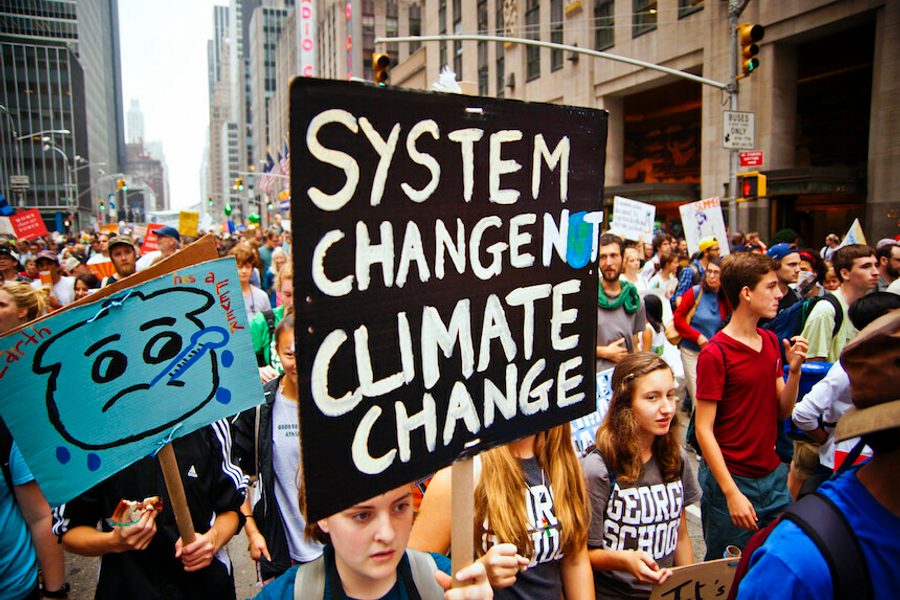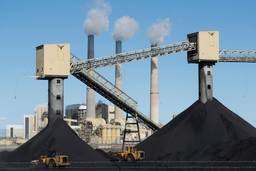In the War Against Climate Change, Physics Isn’t the Enemy—It’s Corporations and the Far Right
Bill McKibben wants a World War II-style mobilization against climate change. But if it’s a war, it’s a class war.
Kate Aronoff

In the New Republic’s September cover story, writer and activist Bill McKibben makes a powerful assertion: Through global warming, physics is waging World War III on humanity — and we need a World War II-style mobilization to defeat it, as we did fascism seventy years ago. “For years now, climate scientists and leading economists have called for treating climate change with the same resolve we brought to bear on Germany and Japan in the last world war,” he warns. Among other studies, McKibben may be referencing climate scientist Kevin Anderson’s call for developed nations to scale back emissions by 10 percent each and every year starting now — as in right now—in order to avert disastrous sea level rise and volatile weather.
“The question is not, are we in a world war?” he says. “The question is, will we fight back? And if we do, can we actually defeat an enemy as powerful and inexorable as the laws of physics?”
For the most part, McKibben is dead-on: As he makes painfully clear in this and other writing, climate change is an existential threat to our species and many others. It might be the single greatest challenge humanity has faced yet — as great and still greater than that faced by the United States during World War II. Comparing today’s deadly storms to the 1930s’ rise of fascism — and today’s governments to Neville Chamberlain’s — is meant to inspire some much needed urgency, appealing to the “spirit of social solidarity” that swept the nation in the early forties as the United States set out to stomp Hitler.
But while there is much to like, McKibben’s WWII metaphor overlooks a few critical aspects of both yesterday and today.
Confronting the climate threat also involves a slew of confounding factors that aren’t strictly climate-related: McKibben frames this fight as a war against physics, discounting crucial questions of power and responsibility embedded in rising greenhouse gas emissions, as well as the rise of a far right as vitriolic as that which surfaced in the days before World War II. If we are to mitigate climate change — and, just as important, enact a humane response to those effects that are already inevitable — we need to name our enemies clearly, and recreate the militancy of the Depression-era social movements that made the most positive aspects of America’s WWII mobilization possible.
War is deadly, and though it was a brutal one that defeated fascism in in the forties, a bigger and more dynamic left today could knock out catastrophic climate change and ascendant xenophobia alike — sans bloodshed. Indeed, it must. And physics may be the wrong foe to galvanize such a force.
A war on climate change doesn’t have to be a war on an abstraction, like our disastrous ones on drugs and terrorism. While we all in some small way contribute to global warming with our cars and hamburgers, global elites do more to cook us in a day than most people could in a lifetime. From the fossil fuel industry’s extractive business model to the carbon-hungry lifestyles of the rich and famous, it’s a relatively small segment of the population driving the lion’s share of global warming. On the production end, a study released in 2013 found that just 90 companies — almost all fossil fuel companies, including private and state-owned firms worldwide — are responsible for two-thirds of global warming. And as for consumption, Stephen Pacala, director of the Princeton Environmental Institute, suggested in 2007 that half of global greenhouse emissions could be traced to less than 8 percent of the world’s population. A 2015 study from Oxfam found the poorest half of the world’s residents account for just 10 percent of fossil fuel-based emissions.
If fighting climate change is a war, it’s class war. Occupy named the 1 percent. For Bernie Sanders’s campaign it was the millionaires and the billionaires. In contrast, the climate movement has long suffered from having an enemy too amorphous to understand, especially in an economy where many struggle to keep food on the table and roofs overhead. As that same climate movement now begins putting a target on the fossil fuel industry’s head with campaigns like those for coal, oil and gas divestment — and in a political moment rapidly turning against elites — why frame a fight to literally save humanity as being about a topic as mundane as gases and weather?
Likening climate change to World War II presents another challenge as well: Fascism today isn’t just a metaphor. Far right parties and politicians are on the rise across Europe, from Marine Le Pen of France’s Front National — eyeing her country’s highest office — to Alternative für Deutschland (Alternative for Germany), which in some polls has become that country’s third largest party. Falling outside the lines of the West’s traditional left-right divide are authoritarian leaders in Russia and Turkey, and violent nationalisms throughout Europe. Vojislav Seselj, an architect of the ethnic cleansing of Muslims in Bosnia, hosted Belgrade’s first pro-Trump rally in August.
Right in the middle of all this sits Trump himself, melding open racism and xenophobia with a strongman populism built on naming politicians and demographics (immigrants, mainly) on whom frustrated Americans can pin their economic woes. The question of whether Trump is a fascist is an interesting, if academic one. One thing that’s painfully clear, though, is that he’s not alone. Nor is he the kind of fluke in American democracy liberals and conservatives alike are trying to paint him as. Even if Trump loses the election, the kind of violent hatred he’s stirred up isn’t going anywhere.
These far right parties — Republicans included — happen to be filled with climate skeptics eager to rip the Paris Agreement to shreds. But for those with an eye toward the climate, there are even more worrying aspects to all this. How might the far-right handle a warming world, one being sped along by their own bad or nonexistent solutions? The best estimates hold that warming could displace anywhere between 25 million and one billion people, many from places (read: the Global South) from which Trump and his ilk would rather not have them coming. America is already having to resettle its own climate refugees in Louisiana, first residents of the slowly submerging Isle de Jean Charles and now those displaced from flooding last month around Baton Rouge. If the far-right succeeds, walls will be built — both borders to keep refugees out, and seawalls to ensure the wealthy can hold onto their seaside property.
That’s because, for all their rants against the global elites, the far right is ultimately fighting for their interests, and will let austerity carry on so long as they get to have their way with the borders. The result might be a wave of governments as hostile to government regulation and international agreements as they are to migrants and communities of color, and where the fossil fuel industry is, consequently, free to run amok.
In such a context, how the United States deals with climate change is as important as whether we do at all. Progressive climate action may not bring a revolution for the Left, but a reactionary response could solidify power for a Right eager to promise protection in an increasingly volatile world. Whether recognized as climate impacts or not, the effects of climbing temperatures stand to create dramatic instability world wide — the kind that capitalists and fascists each love to take advantage of. At the top of the agenda for the climate movement, then, should be ensuring the far right’s swift defeat.
Capitalists and fascists aren’t always separate entities, either. Here we can look to WWII’s predecessor, the Spanish Civil War, where oil company Texaco funneled supplies to General Francisco Franco’s insurgent fascists. As Adam Hochschild points out in Spain In Our Hearts, Texaco head and Nazi sympathizer Torkild Rieber wrote blank checks to Franco’s far-right military coup. The company, since subsumed under Chevron, gifted Spanish Nationalists — who were already backed by Hitler and Mussolini — with lavish lines of credit, strategic intelligence and all the oil money could buy — plus some that it couldn’t. Fueling trucks, boats, tanks and planes, that oil also helped propel Franco’s forces to victory and over 35 years of autocratic rule.
One Franco-era official Hochschild quotes laid out just how good Texaco was to the aspiring regime: “Without American petroleum and American trucks and American credits, we could never have won the civil war.”
Hochschild notes too that Rieber wasn’t alone. Dow Chemical gifted 40,000 bombs to Hitler just before the war began, and the heads of Ford, General Motors, Eastern Kodak and other companies met at New York’s Waldorf Astoria to talk “about the prospects for American cooperation with the Nazi regime.”
Today, the fossil fuel industry is no better friend to democracy than it was in the thirties. While Rieber’s alliance with Franco was driven by ideology, plenty of more recent executives from companies like Coca-Cola and Halliburton dealt with authoritarian regimes for the sake of good business alone. In all likelihood, today’s CEOs will make friends with whoever finds their way into Congress and the Oval Office come November. So long as they make a profit, oil and gas companies will be as happy to deal with a dictatorship as a democracy — maybe even, as Rieber was, happier.
The people driving climate change and the ones who could make its effects truly dystopian are cut from the same cloth. They’ve found plenty of common ground in the last century, and will probably continue to do so no matter how bad things get for the rest of us. The war on warming, then, isn’t one that can stand alone. If we want to save the planet, we need to stop the kinds of people who want to make it a dangerous place for those already worst-off.
We need a World War II-style mobilization against climate change. We also need one against fascism. The path toward each is the same: a stronger and more unified left. Here it’s worth remembering the government’s increased role in the economy started before the war, with the New Deal. This wasn’t just a top-down initiative of kindly Democrats: Massive, disruptive protests forced Roosevelt’s hand in enacting relief programs and labor protections like the National Labor Relations Act. Depression-era mobilizations also transformed the labor left into a powerful voice for working class interests, and a force to be reckoned with in the halls of power once war rolled around in the forties. If Americans remember World War II as one of shared prosperity (and plenty — including many Japanese Americans — do not), it’s in part because the threat of open revolt pushed the White House into a corner a decade before.
With Americans across the political spectrum railing against elites, it’s time to inject the climate fight with a bigger dose of rowdy populism — to take on runaway climate change, corporate power and political xenophobia alike. Mobilizing at the scale demanded by today’s political and physical climate will require naming an “us” versus a “them” more compelling than humanity versus physics, and — in the process — building a left both bigger and more popular than the United States has ever known.
From retractions of civil liberties to violent nationalism, the ways that hawkish states respond to existential threats leave a lot to be desired. War metaphors aside, though, we desperately need the kind of mobilization McKibben outlines: a full court press from government and the private sector. Necessary, too, is one from below, to make that mobilization happen in the first place and ensure it’s worth a damn to the 99 percent.
Kate Aronoff is a staff writer at The New Republic and author of Overheated: How Capitalism Broke the Planet — And How We Fight Back. She is co-author of A Planet To Win: Why We Need a Green New Deal and co-editor of We Own the Future: Democratic Socialism—American Style. Follow her on Twitter @katearonoff.








